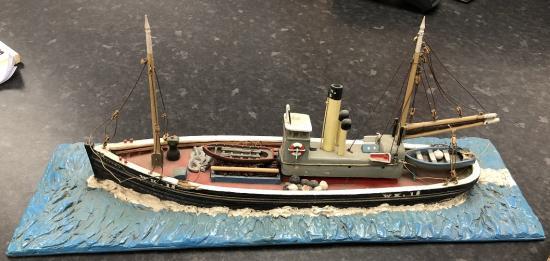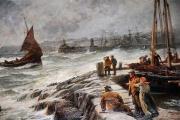UNIQUE STEAM DRIFTER LOTTIE 'SAILS' HOME TO WICK
9th August 2019

From Bill Mowat.
An unique ship from the 'golden era' of Wick's herring catching and food-processing industries has 'sailed back' to her home-port, over 70 years since she ceased having a prominent role at Wick Harbour.
A fine model of the Wick steam drifter Lottie (WK 15) has been bequeathed to The Wick Society by the family of late Mr Jack Slorach, who served for decades at the school dentist for the county of Sutherland.
Lottie is unique in being the only stream drifter built at Wick that went on to spend her entire 40-year career based at the Caithness port.
Mr Slorach was a keen collector of model ships and other antiques at his home in Golspie.
His son John, a graduate of London's famous Central St Martin's arts & design school ... who works in Inverness as a self-employed computer 'war games' creator for the international market-place ... arranged for the transfer via family friend Bill Mowat, the former Highland Councillor for NE Caithness on the Inverness-based local authority.
The 80' long Lottie was built in Wick in 1904 ... when herring landings at Wick were approaching their 1913 peak ... by the Alexander family, whose principals originally came from Keiss.
Dan Alexander's yard ... just to the landward side of the Wick Service Bridge ... was active at the time that Lottie was scrapped at Broadhaven in 1946.
In the immediate post-war era, Wick's last substantial-scale shipyard was kept very busy re-building the local fleet, including creating Wick's last herring drifter, the motor-powered Fisher Boy.
Sir Danny Alexander, who served in the coalition Cabinet as First Secretary to the Treasury whilst MP for Inverness in the early 2010s, is proud of his family links with the shipbuilder, after whom he was named.
A fellow UK Cabinet member at the time, Sir Alan Duncan, also had a Wick herring fishery background, being the grandson of prominent fish sales company owner John S Duncan, a business that still exists, but now as a retail subsidiary of Aberdeen's Wood family business.
The wooden Lottie was built for William Manson, who owned her throughout her career. Both her coal-fired boiler and her compound engine were transported North for fitting, after being manufactured by Alex Hall & Co, in Aberdeen. Unusually for the time, she had a fitted WC.
For what is believed to have been a lengthy spell, Skipper Donald Ploughman was in command while she was fishing.
She was requisitioned by the Government for Great War Service as a tender to Britain's Grand Fleet in Scapa Flow till early 1920.
In World War II, Lottie was again 'called up' for Government service but this time staying close to home as the guard ship .... harbour defence vessel ... for her home-port.
Said Bill Mowat: 'I'm named after my late grandfather Bill, who spent almost his entire fishing career sailing on Wick steam drifters, notably the Morven Hill on which he served as mate for a number of years'
'When I saw the Lottie model, I suggested to John that the Wick Heritage Centre in Bank Row would be the best long-term home for her and his father agreed.
'I presume ... but don't know for certain ... that Mr Manson's daughter was named Charlotte, but known in the family by the pet-name Lottie.
'Skipper Ploughman must have been a very capable fisher; the 1920s and 1930s were exceptionally tough decades for the herring trade, driving the owners of many stream drifters around the coast to bankruptcy'.
'Prior to the outbreak of the Great War, the main markets for high-quality (salt) cured Wick herring were Russia and Germany; but Britain broke off all trade relations with the former after the creation of the Soviet Union in 1917.8.
'Raging inflation swept Germany in the 1920s, following the over-tough terms of the 1919 Versailles Peace Treaty. From that time, is the famous story of one Wick herring exporter who was paid with bundles of billion-mark notes, which he promptly handed over to his wife suggesting that she use them as wall-paper'.
Fifty years earlier, history was made in Wick when the world's first-ever powered fishing boat James Loch was launched in 1869 from the local yard owned by a Mr Steven in Wick, who was also a Keiss native.
Patrons of Wick's Nethercliffe Hotel will be familiar with the engraving of this world-importance 62' long steam drifter.
Drift-fishing ... which dominated the era when Wick was Europe's premier catching and processing port .... was a passive method of operating.
At least twenty drift-nets ... held vertical in the water by buoys on the sea-surface and lead weights on the footings ... were tied together in a 'vertical curtain' 'shot' overboard by the crew in the evening and stretching for up to a mile or more from the vessel.
Shoals of herring swam upwards to the surface at night-time to feed on plankton ... tiny marine creatures ... and were trapped by the gills in the cotton nets, dyed in a dark colour by a wood-based preservative. Those were then hauled by the vessel's steam capstan, with the crew shaking the nets to let the herring fall into the hold for sorting.
The word 'documentary' was coined by Scotland's pioneer cinematographer Mr John Grierson.
His classic 1929 factual movie 'Drifters' ... now available for free viewing on the internet ... shows in detail the methods used by the 12-man crew of the Lottie and hundreds of other Scots and English steam-drifters of that era.
See the film at http://www.screenonline.org.uk/film/id/439877/index.html
Herring and mackerel are still a key multi-million component of Scotland's fishing industry.
But those fisheries are conducted by massive ships costing up to £30 million each and operated by partnerships in wealthy Whalsay island in Shetland or are from Peterhead or Fraserburgh, in Aberdeenshire.
Late last week (26.07.19) one of the world's biggest 'pelagic' (i.e. herring & mackerel) trawlers, the Maartje Theodora from Rostock on Germany's Baltic coast, transited the Pentland Firth heading East. Rostock was one of the key Baltic export harbours in Wick's herring heyday.
The massive fishing vessel is 141 metres ... 462' ... long while Greenpeace activists have 'christened' her as 'the Hoover of the Seas'. It claims that one on occasion that it knows about 1.5 million kilos of herring were illegally dumped overboard as 'discards' during a three-week trip, with its information coming from a whistleblower on board.
Greenpeace claims that two parallel log books were carried on board, one of which aimed to disguise 'denuding the seas' illegal actions, as above.
Notes
Key info on Lottie from 'Steam Drifters Recalled' by Joseph Reid: Volume 3 'Spey to Shetland and Stornoway', published in 2002 that includes c. 60 WK-registered vessels.
See Also
Wick Fishing boats has lots of information contributed by members in our Forum at https://bit.ly/2YUKufl
Related Organisations






